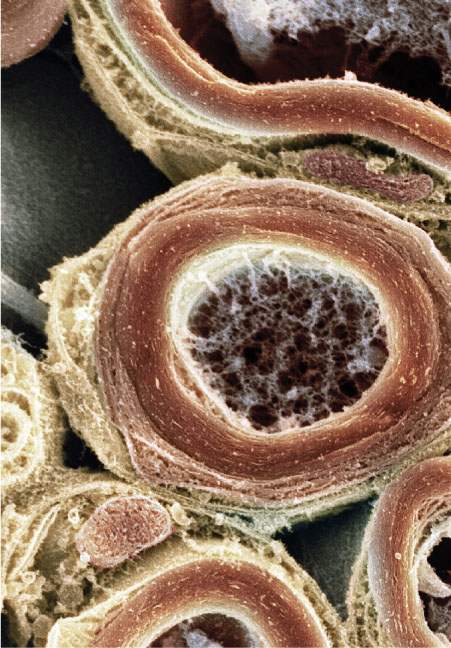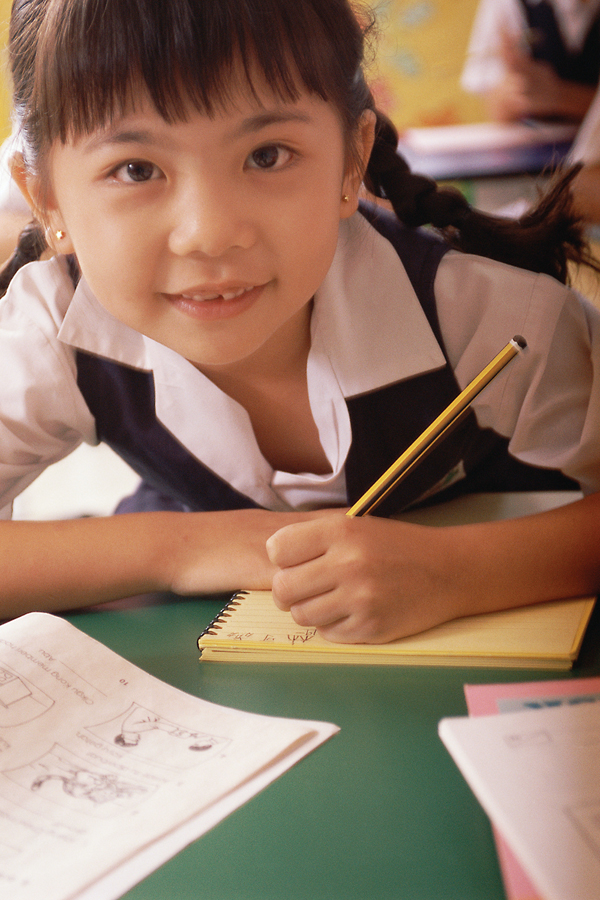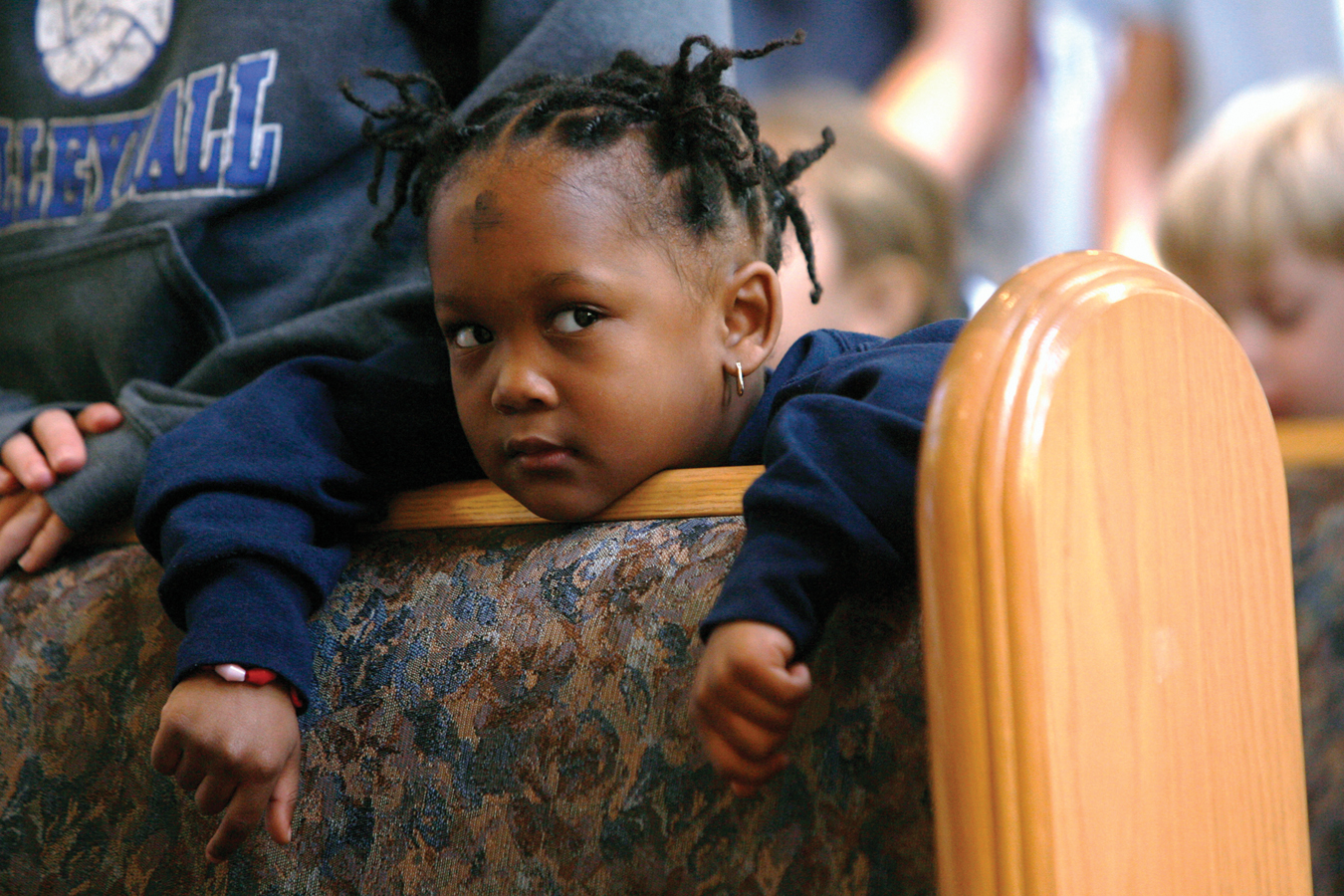 Brain Development
Brain Development
Brains grow rapidly before birth and throughout infancy, as you saw in Chapter 5. By age 2, most neurons have connected to other neurons and substantial pruning has occurred. The 2-

FIGURE 8.2
Connections A few of the dozens of named parts of the brain are shown here. Although each area has particular functions, the entire brain is interconnected. The processing of emotions, for example, occurs primarily in the limbic system, where many brain areas are involved, including the amygdala, hippocampus, and hypothalamus.Since most of the brain is already present and functioning by age 2, what remains to develop? The most important parts!
Although the brains and bodies of other primates seem better than humans in some ways (they climb trees better, for instance) and although many animals have abilities humans lack (smell in dogs, for instance), humans have intellectual capacities far beyond any other animal. Considered from an evolutionary perspective, our brains allowed the human species to develop “a mode of living built on social cohesion, cooperation and efficient planning … survival of the smartest” seems more accurate than survival of the fittest (Corballis, 2011, p. 194).
The social understanding that develops as the prefrontal cortex matures distinguishes humans from other primates. For example, a careful series of tests given to 106 chimpanzees, 32 orangutans, and 105 human 2½-year-
As their brains mature, children become better at controlling their emotions. For example, when a stranger greets them, many 2-
Speed of Thought
myelination The process by which axons become coated with myelin, a fatty substance that speeds the transmission of nerve impulses from neuron to neuron.
After infancy, some brain growth is the result of proliferation of the communication pathways (dendrites and axons). However, most increased brain weight occurs because of myelination. Myelin (sometimes called the white matter of the brain) is a fatty coating on the axons that speeds signals between neurons (see Figure 8.3).
Especially for Early-
Response for Early-

FIGURE 8.3
Faster and Faster Myelination is a lifelong process. Shown here is a cross section of an axon (dark middle) coated with many layers of Schwann cells, as more and more myelin wraps around the axon throughout childhood. Age-Although myelination continues for decades, the effects are especially apparent in early childhood (Silk & Wood, 2011). The areas of the brain that show greatest early myelination are the motor and sensory areas (Kolb & Whishaw, 2013).
Speed of thought from axon to neuron becomes pivotal when several thoughts must occur in rapid succession. By age 6, most children can see an object and immediately name it, catch a ball and throw it, write their ABCs in proper sequence, and so on. In fact, rapid naming of letters and objects—
Of course, adults must be patient when listening to young children talk, helping them get dressed, or watching them write each letter of their names. Everything is done more slowly by 6-
The Brain’s Connected Hemispheres
corpus callosum A long, thick band of nerve fibers that connects the left and right hemispheres of the brain and allows communication between them.
One part of the brain that grows and myelinates rapidly during early childhood is the corpus callosum, a long, thick band of nerve fibers that connects the left and right sides of the brain. Growth of the corpus callosum makes communication between the hemispheres more efficient, allowing children to coordinate the two sides of their brains, and hence both sides of their bodies.
Failure of the corpus callosum to develop results in serious disorders: This failure is one of several possible causes of autism (Frazier et al., 2012).
lateralization Literally, sidedness, referring to the specialization in certain functions by each side of the brain, with one side dominant for each activity. The left side of the brain controls the right side of the body, and vice versa.
To understand the significance of the corpus callosum, note that each side of the body and brain specializes, being dominant for certain functions. This is lateralization, literally, “sidedness.” The entire human body is lateralized, apparent not only in right-
Left-
The Left-Handed Child

Infants and toddlers usually prefer one hand to the other for grabbing spoons and rattles. By age 2 most children have a dominant hand used for scribbling and throwing. Preschool teachers notice that about 1 child in 10 prefers the left hand. Handedness is partly genetic (Goymer, 2007), but many cultures have tried to make everyone right-
Even today, many cultures endorse the belief that being right-
The design of doorknobs, scissors, baseball mitts, instrument panels, and other objects favor the right hand. (Some manufacturers have special versions for lefties, but few young children know to ask for them.) In many Asian and African cultures, the left hand is used only for wiping after defecation; it is an insult to give someone anything with that “dirty” hand.
Developmentalists advise against switching a child’s handedness, not only because this causes adult–
Acceptance of left-
The Whole Brain
Astonishing studies of humans whose corpus callosa were severed to relieve severe epilepsy, as well as research on humans and other vertebrates with intact corpus callosa, have revealed how the brain’s hemispheres specialize. Typically, the brain’s left half controls the body’s right side as well as areas dedicated to logical reasoning, detailed analysis, and the basics of language. Then the brain’s right half controls the body’s left side and areas dedicated to emotional and creative impulses, including appreciation of music, art, and poetry. Thus, the left side notices details and the right side grasps the big picture.
This left–
Further, both sides of the brain are usually involved in every skill. That is why the corpus callosum is crucial. As myelination progresses, signals between the two hemispheres become quicker and clearer, enabling children to become better thinkers and less clumsy.
To pick an easy example: No 2-
Maturation of the Prefrontal Cortex
The entire frontal lobe continues to develop for many years after early childhood; dendrite density and myelination are still increasing in emerging adulthood (Johnson, 2010). Nonetheless, neurological control advances significantly every year between ages 2 and 6, as is evident in several ways:
- Sleep becomes more regular.
- Emotions become more nuanced and responsive.
- Temper tantrums subside.
- Uncontrollable laughter and tears are less common.
One example of the maturing brain is in the game Simon Says. Players are supposed to follow the leader only when orders are preceded by the words “Simon says.” Thus, if leaders touch their noses and say, “Simon says touch your nose,” players are supposed to touch their noses; but when leaders touch their noses and say, “Touch your nose,” no one is supposed to follow the example. Young children lose at this game because they impulsively do what they see and hear. Older children can think before acting. The prefrontal cortex works!
Such advances can be observed in every child, but might personal experience rather than brain maturation be the reason? A convincing demonstration that something neurological, not experiential, is the primary reason for these changes comes from a series of experiments.
These experiments begin with young children given a set of cards with clear outlines of trucks or flowers, some red and some blue. They are asked to “play the shape game,” putting trucks in one pile and flowers in another. Three-
Then children are asked to “play the color game,” sorting the cards by color. Most children under age 4 fail. Instead they sort by shape, as they had done before. This basic test has been replicated in many nations; 3-
When this result was first obtained, experimenters thought perhaps the children didn’t have enough experience to know their colors; so the scientists switched the order, first playing “the color game.” Most 3-
Researchers are looking into many possible explanations for this result (Müller et al., 2006; Marcovitch et al., 2010; Ramscar et al., 2013). All agree, however, that something in the brain must mature before children are able to switch from one way of sorting objects to another. [Lifespan Link: Maturation of the prefrontal cortex is also discussed in Chapter 5, Chapter 11, and Chapter 14.]
Impulsiveness and Perseveration
Neurons have only two kinds of impulses: on–
impulse control The ability to postpone or deny the immediate response to an idea or behavior.
Many young children are notably unbalanced. They are impulsive, flitting from one activity to another. That explains why many 3-
perseveration The tendency to persevere in, or stick to, one thought or action for a long time.
During the same age period, the see-
Many explanations are plausible, but the tendency is unmistakable. Often young children repeat one phrase or question again and again, and often once they start giggling they find it hard to stop. Another example of perseveration occurs when a child has a tantrum when told to stop an activity. (Wise teachers give a warning—
Impulsiveness and perseveration are opposite manifestations of the same underlying cause: immaturity of the prefrontal cortex. No young child is perfect at regulating attention; impulsiveness and perseveration are evident in every 2-

Over the years of childhood, from ages 2 to 12, brain maturation (innate) and emotional regulation (learned) increase: Most older children can pay attention and switch activities as needed. By early adolescence, children change tasks at the sound of the bell—
Exceptions include children diagnosed with attention-
As with all biological maturation, development of impulse control and behavioral flexibility is related to culture—
This study included the shape–
Emotions and the Brain
Now that we have considered the prefrontal cortex, we turn to another region of the brain, sometimes called the limbic system, the major system for emotions. Emotional expression and emotional regulation advance during early childhood. [Lifespan Link: Emotional regulation is discussed further in Chapter 10 and Chapter 15.] Crucial to that advance are three parts of the brain—
The Limbic System
amygdala A tiny brain structure that registers emotions, particularly fear and anxiety.
The amygdala is a tiny structure deep in the brain, about the same shape and size as an almond. It registers emotions, both positive and negative, especially fear (Kolb & Whishaw, 2013). Increased amygdala activity is one reason some young children have terrifying nightmares or sudden terrors, overwhelming the prefrontal cortex. A child may refuse to enter an elevator or may hide from a nightmare. The amygdala responds to comfort but not to logic. If a child is terrified of, say, a dream of a lion in the closet, an adult should not laugh but might open the closet door and command the lion to go home.
hippocampus A brain structure that is a central processor of memory, especially memory for locations.
Another structure in the emotional network is the hippocampus, located right next to the amygdala. A central processor of memory, especially memory for locations, the hippocampus responds to the anxieties of the amygdala by summoning memory. A child can remember, for instance, whether previous elevator-
Early memories of location are fragile because the hippocampus is still developing. Nonetheless, emotional memories from early childhood can interfere with expressed, rational thinking: An adult might have a panic attack but not know why.
The interaction of the amygdala and the hippocampus is sometimes helpful, sometimes not; fear can be constructive or destructive (LaBar, 2007). Studies performed on some animals show that when the amygdala is surgically removed, the animals are fearless in situations that should scare them. For instance, a cat without an amygdala will stroll nonchalantly past monkeys—
hypothalamus A brain area that responds to the amygdala and the hippocampus to produce hormones that activate other parts of the brain and body.
A third part of the limbic system, the hypothalamus, responds to signals from the amygdala (arousing) and to signals from the hippocampus (usually dampening) by producing cortisol, oxytocin, and other hormones that activate parts of the brain and body (see Figure 8.4). Ideally, this hormone production occurs in moderation (Tarullo & Gunnar, 2006).
Especially for Neurologists Why do many experts think the limbic system is an oversimplified explanation of brain function?
Response for Neurologists: The more we discover about the brain, the more complex we realize it is. Each part has specific functions and is connected to every other part.

FIGURE 8.4
A Hormonal Feedback Loop This diagram simplifies a hormonal linkage, the HPA (hypothalamus-As the limbic system develops, young children watch their parents’ emotions closely. If a parent looks worried when entering an elevator, the child may fearfully cling to the parent when the elevator moves. If this sequence recurs often enough, the child may become hypersensitive to elevators, as fear from the amygdala joins memories from the hippocampus, increasing cortisol via the hypothalamus. If, instead, the parent makes elevator riding fun (letting the child push the buttons, for instance), initial feelings of fear subside, and the child’s brain will be aroused to enjoy elevators—
Knowing the varieties of fears and joys is helpful when a teacher takes a group of young children on a trip. To stick with the elevator example, one child might be terrified while another child might rush forward, pushing the close button before the teacher enters. Every experience (elevators, fire engines, subways, animals at the zoo, a police officer) is likely to trigger a range of emotions, without much reflection, in a group of 3-
Stress Hormones
Cortisol, which is the primary stress hormone, may flood the brain and destroy part of the hippocampus. Does that mean a young child’s life should be stressfree? No, some cortisol is needed for normal development. However, there is “extensive evidence of the disruptive impacts of toxic stress” (Siegel et al., 2013). Too much cortisol early in life may lead to permanent deficits in learning and health, with major depression, post-
Yet, stress may sometimes be helpful. Ongoing research seeks to discover exactly how and when stress harms the human brain. Emotionally-
In an experiment conducted by Teoh and Lamb (2013), brain scans and hormone measurements were taken of 4-

Another study found that children remembered more when they were interrogated by a friendly interviewer (Quas et al., 2004). Generally, a child’s memory is more accurate when an interviewer is warm and attentive. This finding is particularly useful if a child witnesses a crime (Teoh & Lamb, 2013).
Context is always crucial: Stress can facilitate memory and learning if adults are reassuring. Because of individual variations in genes and early childhood, a study of 5-
In addition to such individual differences, a crucial factor is past history, specifically whether or not the children experienced chronic early stress. A young child who experienced neglect or abuse day after day may become unable to use his or her brain/cortisol connection to adjust to stress later on (Evans & Kim, 2013).
Studies of children who have been maltreated suggest that excessive stress hormones in early childhood may permanently damage the brain, blunting or accelerating emotional responses lifelong (Wilson et al., 2011). Sadly, this topic leads again to research on those adopted Romanian children mentioned in Chapter 7. When they saw pictures of happy, sad, frightened, or angry faces, their limbic systems were less reactive than were those of Romanian children living with their biological parents. Their brains were also less lateralized, suggesting less specialized, less efficient thinking (Parker & Nelson, 2005). Thus early stress had probably damaged their brains.
Romania no longer permits wholesale international adoptions. Nonetheless, as mentioned earlier, some Romanian children are raised in institutions. In one study, several of them were randomly assigned to foster homes at about age 2. By age 4, they were smarter (by about 10 IQ points) than those who remained institutionalized (Nelson et al., 2007). This research suggests that ages 2 to 4 constitute a sensitive time for brain growth, as measured by tests of language and memory.
SUMMING UP
The brain continues to mature during early childhood. Myelination is notable in several crucial areas. One is the corpus callosum, which connects the two sides of the brain and therefore allows control of the two sides of the body. Increased myelination speeds up actions and reactions. Furthermore, the prefrontal cortex enables the balancing of action and inhibition, allowing children to think before they act and to stop one action to begin another. As impulsiveness and perseveration decrease, children become better able to learn.
Several key areas of the brain—